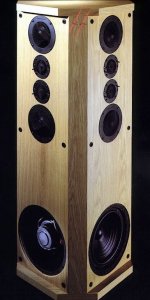If I was going to build a set of surround speakers from scratch what are the requirements that need to be met. Such as frequencies, from what I have read I only need to go down to about 60-80 hz. My idea would be a 8" or 10" woofer for the low end and a square tractrix for tweeter as a 2 way. What are some of the specs I need to look at when pairing speakers and drivers. I figured the efficiency needs to be close between the 2 drivers. Do I look for 4 or 8 or 16 ohm drivers. One of the horns I was looking at was,
FaitalPRO LTH102 1" 60 x 50 Elliptical Tractrix Horn 2/3-Bolt
Much help would be greatly appreciated.
Thanks
FaitalPRO LTH102 1" 60 x 50 Elliptical Tractrix Horn 2/3-Bolt
Much help would be greatly appreciated.
Thanks
I can't recall where, but I saw a DIY surround speaker made of the Faital HF10AK, LTH102, and 10FH530 components. The crossover was in the neighborhood of 1.2KHz to 1.4KHz.
I can't recall where, but I saw a DIY surround speaker made of the Faital HF10AK, LTH102, and 10FH530 components. The crossover was in the neighborhood of 1.2KHz to 1.4KHz.
I will have to search for that, some of those components are pricey but what match.
I am all so looking for other alternatives to the horn, I was looking at some ev horns.
Then again readily available parts are a plus to.
Thanks for the info.
There should two primary design objectives with surround loudspeakers:
1. Timbrally similar to the mains and center.
2. Low propagation loss with distance.
The first has to do with the on and off axis response. You want that to match the mains as much as possible. The second has to do with localization of the near surround speaker to people who are not in the sweet spot.
It's all there in Toole's book. He recommends a reverse CBT-like line array to get around the propagation loss problem.
1. Timbrally similar to the mains and center.
2. Low propagation loss with distance.
The first has to do with the on and off axis response. You want that to match the mains as much as possible. The second has to do with localization of the near surround speaker to people who are not in the sweet spot.
It's all there in Toole's book. He recommends a reverse CBT-like line array to get around the propagation loss problem.
ra7 makes a very good point there. Your traditional two way MT speaker is a bit of a nightmare in public address situations. Why? Because, being spherical waves, power falls off as inverse square.
That means the people next to the speaker get deafened, and the people far away can hardly hear it! 😕
You're going to make it even worse with highly directional horns.
Line arrays of several stacked drivers are the solution. They fall off as inverse distance, being cylindrical waves. In an ideal world you'd build them into the wall.
At the very least you want MTTM arrays. There's an advantage that you can use smaller drivers which have wider dispersion too. Centre is a problem since ergonomics often incline you towards sub-optimal horizontally aligned centre, but left and right and smaller rears can be done with traditional cone type MTTM easily enough. At ear level.
Roy Allison's beautiful IC20 was a brilliant solution to creating an even sound field in the room. This would make a good main left and right speaker. The bass near the floor effectively doubles the bass drive units too. 😎
That means the people next to the speaker get deafened, and the people far away can hardly hear it! 😕
You're going to make it even worse with highly directional horns.
Line arrays of several stacked drivers are the solution. They fall off as inverse distance, being cylindrical waves. In an ideal world you'd build them into the wall.
At the very least you want MTTM arrays. There's an advantage that you can use smaller drivers which have wider dispersion too. Centre is a problem since ergonomics often incline you towards sub-optimal horizontally aligned centre, but left and right and smaller rears can be done with traditional cone type MTTM easily enough. At ear level.
Roy Allison's beautiful IC20 was a brilliant solution to creating an even sound field in the room. This would make a good main left and right speaker. The bass near the floor effectively doubles the bass drive units too. 😎
Attachments
- Status
- Not open for further replies.
